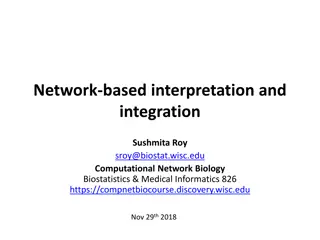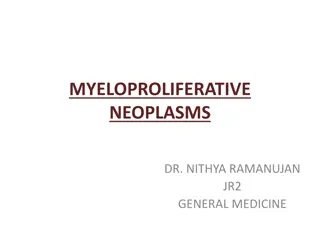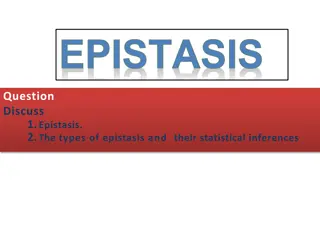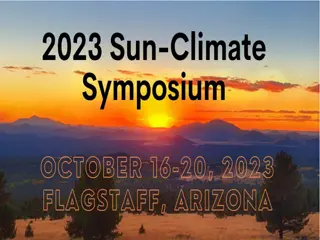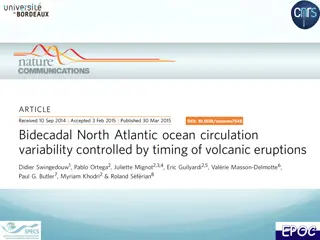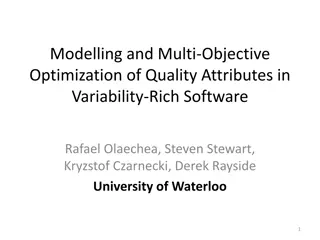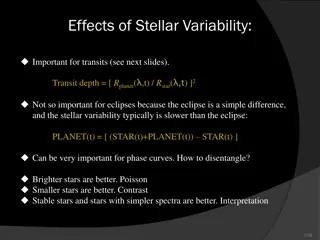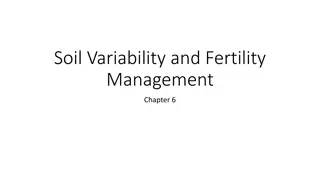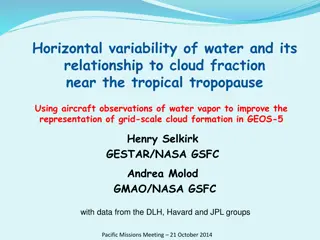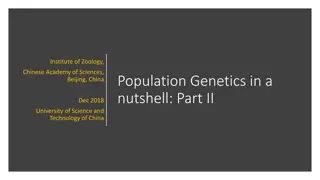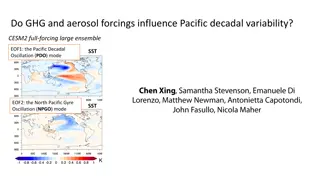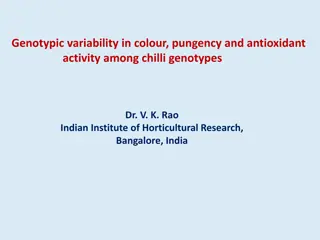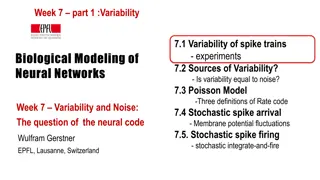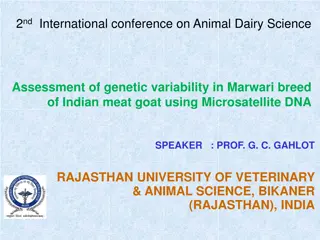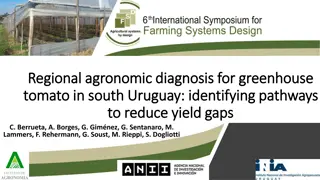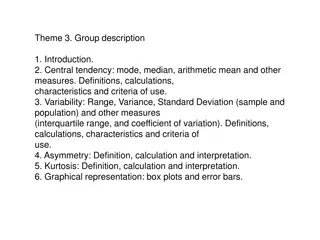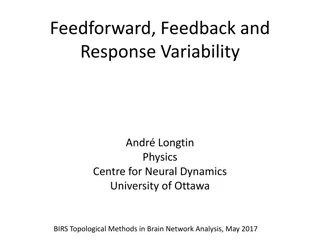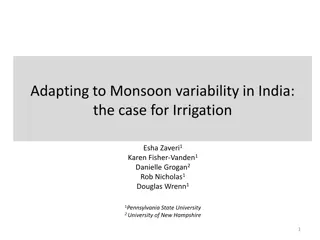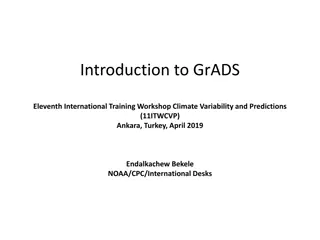Carcinogenesis
The multistep process of carcinogenesis at both phenotypic and genetic levels, including excessive growth, local invasion, and metastasis. Explore the six changes in normal cell physiology that result in cancer formation and the mechanisms of action of oncoproteins. Discover the role of important ge
7 views • 17 slides
Impact of Indian Ocean Dipole on Central Africa Rainfall Variability
Workshop on Indian Ocean Variability and Teleconnections discussed the assessment of the link between Indian Ocean Dipole (IOD) and rainfall variability in Central Africa. The study utilized precipitation data, sea surface temperatures, and dynamic variables to analyze the impact of IOD events on Ce
4 views • 7 slides
fMRI Coregistration and Spatial Normalization Methods
fMRI data analysis involves coregistration and spatial normalization to align functional and structural images, reduce variability, and prepare data for statistical analysis. Coregistration aligns images from different modalities within subjects, while spatial normalization achieves precise anatomic
3 views • 35 slides
Understanding Network Perturbations in Computational Biology
Network-based interpretation and integration play a crucial role in understanding genetic perturbations in biological systems. Perturbations in networks can affect nodes or edges, leading to valuable insights into gene function and phenotypic outcomes. Various algorithms, such as graph diffusion and
0 views • 55 slides
Understanding Myeloproliferative Neoplasms: Overview and Clinical Considerations
Myeloproliferative neoplasms (MPNs) include a group of disorders characterized by overproduction of blood cells. The WHO classification outlines eight disorders with varied clinical presentations and potential for transformation. These disorders, such as CML, CNL, and PV, exhibit significant phenoty
2 views • 58 slides
Understanding Epistasis: Types and Inferences
Epistasis is the interaction between genes where one gene's allele masks the expression of another gene. Various types of epistasis, such as dominant and recessive epistasis, can be observed, impacting the phenotypic ratios. Statistical inferences can help analyze epistatic interactions in genetic s
0 views • 35 slides
Understanding Measures of Dispersion in Statistics
Measures of dispersion in statistics help in understanding the variability of data points. They are essential for assessing the reliability of central tendency measures, comparing data sets, identifying variability causes, and guiding further statistical analysis. The properties of a good measure of
0 views • 8 slides
Understanding Variation in Statistical Studies
Variability is key in statistical studies, shaping the essence of statistical analysis. Students often struggle to grasp the concept of variability, despite being taught statistical methods. The term "variation" takes on different meanings in various statistical contexts, presenting challenges in co
2 views • 54 slides
Understanding Measures of Variability: Variance and Standard Deviation
This lesson covers the concepts of variance and standard deviation as measures of variability in a data set. It explains how deviations from the mean are used to calculate variance, and how standard deviation, as the square root of variance, measures the average distance from the mean. Degree of fre
1 views • 26 slides
Understanding Variability in One-Variable Data Analysis
Exploring the concept of variability in statistical analysis of one-variable data, focusing on key measures such as range, interquartile range, and standard deviation. Learn how to interpret and calculate these metrics to understand the spread of data points and identify outliers. Utilize quartiles
0 views • 19 slides
Building an Active Region Database for Solar Irradiance Variability Using SDO Images
San Fernando Observatory (SFO) at California State University Northridge is leveraging ground-based and space-based images to fill data gaps in solar images and develop a database for studying Total Solar Irradiance (TSI) variability. By extracting active-region information from Solar Dynamics Obser
5 views • 21 slides
Addressing Learner Variability: Understanding UDL in Education
This content explores the concept of Universal Design for Learning (UDL) in education, highlighting the need to address learner variability in the classroom. It discusses the challenges in providing equitable access to learning for all students and presents data on student proficiency in reading. Th
0 views • 49 slides
Understanding Atlantic Overturning Observed and Simulated Variability
Exploring the initiation of the Atlantic overturning using observations and simulation reconstructions with models. Analysis of historical agreement, synchronisation, and control simulations. Investigation of a 20-year cycle in sea ice cover, feedback mechanisms, and the impact of events like the Mt
0 views • 32 slides
Modelling and Optimization of Quality Attributes in Software Variability
Modelling and multi-objective optimization of quality attributes in variability-rich software is crucial for customizing software functionality to meet stakeholders' diverse needs. This involves addressing conflicting quality requirements such as cost, reliability, performance, and binary footprint
0 views • 34 slides
Understanding Stellar Variability Effects in Exoplanet Studies
Exploring the impact of stellar variability on exoplanet transits and eclipses, this content delves into strategies for disentangling signals in phase curves. Factors such as stellar brightness, size, and stability play crucial roles. Illustrations and studies by Pont et al. shed light on phenomena
0 views • 7 slides
Understanding Descriptive Statistics in Data Analysis
Descriptive statistics provide a vital framework for analyzing data by focusing on three key characteristics: measures of center, dispersion, and shape. Standard deviation, a fundamental measure, helps assess variability in distributions through the Empirical Rule and Chebyshev's Theorem. These prin
0 views • 27 slides
Soil Variability and Fertility Management
Addressing challenges in crop production involves managing soil nutrients, moisture content, and variability. Precision agriculture techniques offer solutions such as site-specific nutrient management and mathematical approaches for matching fertilizer recommendations. This chapter discusses sources
0 views • 72 slides
Exploring French H-Aspir, Glottal Stop, and Production Planning Domains
The research delves into the variability of the French "h aspir" phenomenon, which includes the presence of glottal stops and its impact on production planning. It discusses cases of both H-aspir-generated glottal stops and glottal stops occurring after unpronounced liaison consonants. The study she
0 views • 33 slides
Understanding Sampling Variability in Statistical Analysis
Random sampling is crucial in statistical analysis to minimize sampling error. Sampling variability occurs due to chance when a random sample is surveyed instead of the entire population. Different units selected can lead to slightly varied estimates. It's important to understand and address samplin
1 views • 31 slides
Understanding Central Tendency and Variability in Distributions
Central tendency and variability are fundamental features of statistical distributions. Central tendency, encompassing mean, median, and mode, represents the middle of a distribution, while variability describes the spread of data points. Knowing the effect of distribution shape on these measures he
0 views • 25 slides
Understanding Water Variability and Cloud Formation near Tropical Tropopause
Exploring the horizontal variability of water and its relation to cloud fraction using aircraft observations to enhance grid-scale cloud formation representation in GEOS-5. Addressing the chronic water vapor issue in GEOS-5, potential causes, motivating science questions, and methodologies to improv
0 views • 17 slides
Understanding Population Genetics: Mutations, Variability, and Evolution
Explore the fascinating world of population genetics, covering key concepts like the history of population genetics, mutation types, measurement of variability, and mutation rates. Delve into the diverse mutations such as substitutions, insertions, deletions, and duplications, along with how these v
0 views • 47 slides
Variability in Training Duration for Acquiring Absolute Pitch Ability
Sakakibara's study on acquiring absolute pitch ability revealed significant variability in the time taken by participants to pass pitch identification tests. Genetic predisposition may play a role, as differences were observed independent of factors like age, gender, and music experience. The study
0 views • 17 slides
Understanding North Atlantic Hurricane Drought and Aerosol Impact
This study explores the influence of sulfate aerosols on the late 20th-century North Atlantic Hurricane drought, focusing on the interaction of European sulfate aerosols and African dust. It investigates the radiative forcing effects and variability in hurricane activity, proposing hypotheses relate
0 views • 17 slides
Influence of GHG and Aerosol Forcings on Pacific Decadal Variability in CESM2
The study investigates how greenhouse gas (GHG) and aerosol forcings impact Pacific decadal variability (PDV) through the analysis of CESM2 full-forcing large ensemble data. It explores the influence on the Pacific Decadal Oscillation (PDO) and North Pacific Gyre Oscillation (NPGO) modes, long-term
0 views • 5 slides
Understanding Heterogeneity in Hypophosphatasia: A Case Study in Phenotypic Variability
This case study explores the diverse expression of hypophosphatasia in a Caucasian female patient, highlighting the challenges in diagnosis and treatment. The patient presented with chronic pain, fractures, myopathy, and dental issues, underscoring the complexity of genotype-phenotype correlations i
0 views • 23 slides
Genotypic Variability in Chilli: Colour, Pungency, and Antioxidant Activity
This study explores the genotypic variability in colour, pungency, and antioxidant activity among different chilli genotypes, highlighting the importance of chillies as a major spice crop in India and various other countries. The research aims to analyze the extent of variability in key parameters s
0 views • 31 slides
Understanding Fabrication Variability in Semiconductor Manufacturing
Fabrication variability in semiconductor manufacturing refers to variations in physical characteristics of transistors, impacting their electrical parameters. This variability, whether systematic or random, can lead to performance deviations in digital circuits, affecting power consumption, timing,
0 views • 48 slides
Exploring Variability and Noise in Neural Networks
Understanding the variability of spike trains and sources of variability in neural networks, dissecting if variability is equivalent to noise. Delving into the Poisson model, stochastic spike arrival, and firing, and biological modeling of neural networks. Examining variability in different brain re
0 views • 71 slides
Overview of Genetic Variability in Marwari Breed of Indian Meat Goat
The presentation at the 2nd International Conference on Animal Dairy Science discussed the assessment of genetic variability in the Marwari breed of Indian meat goat using Microsatellite DNA by Prof. G.C. Gahlot from Rajasthan University of Veterinary & Animal Science, Bikaner. The global goat popul
0 views • 19 slides
Thermal ELCC Study Results for Electric Reliability Council of Texas
Study results on Resource Accreditation, Planning Reserve Margin, and Thermal ELCCs for maintaining grid reliability, considering uncertainty factors like load variability, growth, and generator outages. Exploring UCAP accreditation, outage variability, and interactive effects on fleet-wide thermal
0 views • 39 slides
Regional Agronomic Diagnosis for Greenhouse Tomato in South Uruguay
The sustainability of vegetable farms in South Uruguay is at risk due to low crop yields, which are significantly lower than attainable yields in the region. A study was conducted to identify strategies to reduce yield gaps for greenhouse tomato crops. By analyzing yield variability and gaps among f
0 views • 21 slides
Exploring Measures of Central Tendency and Variability in Statistics
Understand the concepts of central tendency (mode, median, mean) and variability (range, variance, standard deviation) in statistics. Explore calculations, characteristics, and criteria of use, along with asymmetry, kurtosis, and graphical representations like box plots. Discover how these statistic
0 views • 31 slides
Understanding Neural Response Variability and Connectivity Dynamics
Explore the intricate relationship between feedforward, feedback, and response variability in neural networks. Dive into the impact of noise on effective connectivity and network topology, as well as the challenges posed by noisy and delayed communication between brain regions. Discover the applicat
0 views • 14 slides
Deciphering Climate Variability Through Ocean Buoys Data Collection
Ocean buoys like TAO/TRITON provide valuable data on climate variability by measuring various parameters like sea-surface temperature, wind speed, humidity, and subsurface temperatures. Anomalies from normal conditions help identify patterns over time, aiding in understanding climate changes. Mainta
0 views • 5 slides
Understanding Bacterial Genetics: Phenotypic and Genotypic Variability
Phenotypic and genotypic variations in bacteria are crucial for their adaptation and survival. Phenotype reflects the physical expression influenced by both the genome and the environment, while genotype represents the hereditary constitution passed to offspring. Mutations are a primary source of ge
0 views • 23 slides
Adapting to Monsoon Variability in India: The Case for Irrigation
This study explores the impact of monsoon variability on crop irrigation in India using an empirical model. It examines changes in crop irrigated areas in response to monsoon variations, focusing on rice, wheat, and sorghum. The research analyzes crop water needs, sensitivity to drought, and irrigat
0 views • 11 slides
Reactive Clocks with Variability-Tracking Jitter in ICCD 2015
Explore the research on reactive clocks with variability-tracking jitter presented at ICCD 2015. The study delves into the cost of variability margins, timing analysis, clock variability comparison between PLL and reactive clocks, and adaptive frequency utilization. Understand the benefits and impli
0 views • 24 slides
Understanding Standard Deviation and Standard Error of the Means
Standard deviation measures the variability or spread of measurements in a data set, while standard error of the means quantifies the precision of the mean of a set of means from replicated experiments. Variability is indicated by the range of data values, with low standard deviation corresponding t
0 views • 7 slides
Introduction to GrADS Training Workshop on Climate Variability and Predictions
The GrADS Eleventh International Training Workshop on Climate Variability and Predictions held in Ankara, Turkey in April 2019 was conducted by Endalkachew Bekele from NOAA/CPC/International Desks. The workshop covered topics like GrADS tutorial files, Grid Analysis and Display System, and Control/D
0 views • 23 slides



